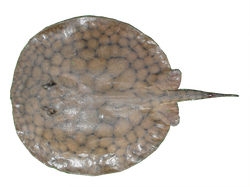Our research projects
Diversity, ecology and conservation of freshwater stingrays: |
Project Leader: Luis O. Lucifora.
The Río de la Plata Basin, the second largest South American watershed after the Amazon, has a rich fauna of freshwater stingrays of the genus Potamotrygon. Scientific research on freshwater stingrays of this basin has been neglected during the last four decades. As a consequence, the systematics, ecology, and conservation status of these intriguing fish are unknown. Five of the valid species of freshwater stingray of the Río de la Plata basin are categorized as "Data Deficient" by the IUCN; the remaining two have not been evaluated yet. The objectives of this project are to resolve taxonomic issues for this group of species, to estimate the actual geographic distribution of each species, and to estimate life history parameters and the ecological role of each species. Also, with this information, we will be able to obtain a measurement of the exposure of each species to different threats (for example, fishing pressure or habitat modification), and a clear picture of the geographic distribution of diversity and endemisms. An important component of this project is the estimation of movement patterns of freshwater stingrays, as some species, such as the giant Potamotrygon brachyura, may be negatively affected by anthropogenic barriers erected in rivers (for example, hydropower dams). Results of the project have already been published in the journals Current Biology, Biological Conservation and Marine and Freshwater Research.
This project is conducted in association with Santiago A. Barbini, Juan M. Díaz de Astarloa and Ezequiel Mabragaña (all three from the Instituto de Investigaciones Marinas y Costeras), Pablo A. Scarabotti (Instituto Nacional de Limnología), Facundo Vargas (Fauna y Pesca Chaco), and Leandro Balboni (Dirección Nacional de Pesca Continental).
The Río de la Plata Basin, the second largest South American watershed after the Amazon, has a rich fauna of freshwater stingrays of the genus Potamotrygon. Scientific research on freshwater stingrays of this basin has been neglected during the last four decades. As a consequence, the systematics, ecology, and conservation status of these intriguing fish are unknown. Five of the valid species of freshwater stingray of the Río de la Plata basin are categorized as "Data Deficient" by the IUCN; the remaining two have not been evaluated yet. The objectives of this project are to resolve taxonomic issues for this group of species, to estimate the actual geographic distribution of each species, and to estimate life history parameters and the ecological role of each species. Also, with this information, we will be able to obtain a measurement of the exposure of each species to different threats (for example, fishing pressure or habitat modification), and a clear picture of the geographic distribution of diversity and endemisms. An important component of this project is the estimation of movement patterns of freshwater stingrays, as some species, such as the giant Potamotrygon brachyura, may be negatively affected by anthropogenic barriers erected in rivers (for example, hydropower dams). Results of the project have already been published in the journals Current Biology, Biological Conservation and Marine and Freshwater Research.
This project is conducted in association with Santiago A. Barbini, Juan M. Díaz de Astarloa and Ezequiel Mabragaña (all three from the Instituto de Investigaciones Marinas y Costeras), Pablo A. Scarabotti (Instituto Nacional de Limnología), Facundo Vargas (Fauna y Pesca Chaco), and Leandro Balboni (Dirección Nacional de Pesca Continental).
Ecology and conservation of marine cartilaginous fishes:
Project Leader: Luis O. Lucifora.
Approximately 90 species of sharks, skates, rays and chimaeras occur on the continental shelf off Argentina. Many of them are still not properly known. For this reason, we are conducting research to obtain basic ecological information (age, maturity, feeding habits) for poorly known species. In addition, we are using non-conventional data sources to estimate population trends of species, such as large sharks, for which there are no long-term data on abundance. Another objective of the project is the synthesis of existing knowledge to obtain general patterns of the ecology and conservation of cartilaginous fishes. This includes the use of species distribution modelling to obtain individual species range maps and the geographic distribution of diversity and endemism of cartilaginous fishes off Argentina. Some results of this project have been published in journals such as Canadian Journal of Fisheries and Aquatic Sciences, PLoS One, Estuaries and Coasts, and Current Zoology.
This project is conducted in association with Santiago A. Barbini (Instituto de Investigaciones Marinas y Costeras).
Approximately 90 species of sharks, skates, rays and chimaeras occur on the continental shelf off Argentina. Many of them are still not properly known. For this reason, we are conducting research to obtain basic ecological information (age, maturity, feeding habits) for poorly known species. In addition, we are using non-conventional data sources to estimate population trends of species, such as large sharks, for which there are no long-term data on abundance. Another objective of the project is the synthesis of existing knowledge to obtain general patterns of the ecology and conservation of cartilaginous fishes. This includes the use of species distribution modelling to obtain individual species range maps and the geographic distribution of diversity and endemism of cartilaginous fishes off Argentina. Some results of this project have been published in journals such as Canadian Journal of Fisheries and Aquatic Sciences, PLoS One, Estuaries and Coasts, and Current Zoology.
This project is conducted in association with Santiago A. Barbini (Instituto de Investigaciones Marinas y Costeras).
Population ecology of broad-snouted caimans of the Atlantic Forest:
Project Leader: Agustín Solari.
Broad-snouted caimans (Caiman latirostris) are top predators in the food webs of streams and rivers of the Atlantic rainforest. There is some evidence that forest-dwelling broad-snouted caiman populations are more isolated and have less reproductive success than populations inhabiting more open habitats. This suggests that forest-dwelling populations could be at a higher risk of decline or extirpation than open-habitat populations. These differences between populations of different habitats require the estimation of population parameters separately, since the extrapolation of parameters between populations can lead to serious errors of estimation. However, no information is available on population size, temporal trends or genetic structure of broad-snouted caimans in the Iguazú National Park, which protects one of the largest remnants of the Atlantic Rainforest. Obtaining this information is crucial to understand what factors may affect populations of broad-snouted caimans and produce population fluctuations in one of the world's biodiversity hotspots. To collect this information, we are conducting standardized caiman surveys along the Iguazú River to estimate population trends. We are also developing a collection of tissue samples with the aim of estimating the level of population structure. The first results of this project have been published in the journal Aquatic Conservation: Marine and Freshwater Ecosystems.
This project is conducted in association with Justo Herrera (Administración de Parques Nacionales) and Alejandro R. Giraudo (Instituto Nacional de Limnología).
Broad-snouted caimans (Caiman latirostris) are top predators in the food webs of streams and rivers of the Atlantic rainforest. There is some evidence that forest-dwelling broad-snouted caiman populations are more isolated and have less reproductive success than populations inhabiting more open habitats. This suggests that forest-dwelling populations could be at a higher risk of decline or extirpation than open-habitat populations. These differences between populations of different habitats require the estimation of population parameters separately, since the extrapolation of parameters between populations can lead to serious errors of estimation. However, no information is available on population size, temporal trends or genetic structure of broad-snouted caimans in the Iguazú National Park, which protects one of the largest remnants of the Atlantic Rainforest. Obtaining this information is crucial to understand what factors may affect populations of broad-snouted caimans and produce population fluctuations in one of the world's biodiversity hotspots. To collect this information, we are conducting standardized caiman surveys along the Iguazú River to estimate population trends. We are also developing a collection of tissue samples with the aim of estimating the level of population structure. The first results of this project have been published in the journal Aquatic Conservation: Marine and Freshwater Ecosystems.
This project is conducted in association with Justo Herrera (Administración de Parques Nacionales) and Alejandro R. Giraudo (Instituto Nacional de Limnología).







